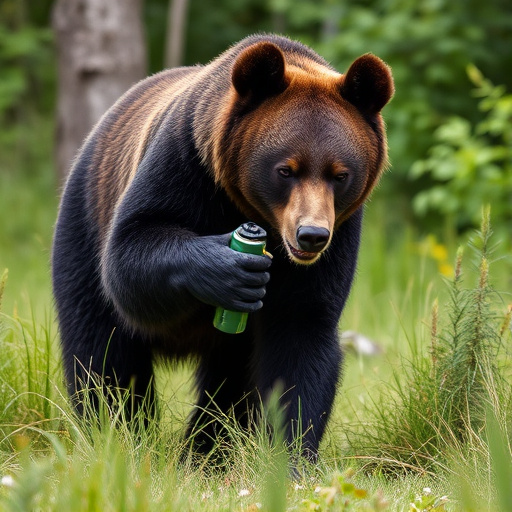Bear spray, a capsaicin-based repellent, is highly effective (80-97%) in deterring bears when used correctly. Success rates peak at 98% with close-range spraying (under 20 feet) against black bears. Weather, terrain, and bear behavior significantly impact the effective range (20-70 feet). Regular practice, proper product selection, and adherence to instructions are crucial for maximum protection in bear country, especially during outdoor adventures in Alaska.
“Alaska’s rugged terrain hosts diverse wildlife, including bears, making bear repellent a vital tool for outdoor enthusiasts. This article delves into the intricacies of bear spray, exploring its effectiveness and maximum range. We’ll unravel the science behind success rate statistics, dissecting factors like distance, wind, and bear behavior. Additionally, we offer practical tips to maximize protection during outdoor adventures. Understanding these key aspects ensures safety in Alaska’s beautiful yet unpredictable wilderness.”
- Understanding Bear Spray: The Basics and Its Mechanism
- Deciphering Bear Repellent Maximum Range: Factors Influencing Effectiveness
- Unveiling the Science Behind Bear Spray Success Rate Statistics
- Maximizing Protection: Tips for Optimal Use and Beyond
Understanding Bear Spray: The Basics and Its Mechanism
Bear spray, also known as bear repellent, is a widely used tool for personal safety in areas where bears are present. Understanding its mechanism and effectiveness is crucial when considering its maximum range and overall success rate. The primary active ingredient in bear spray is capsaicin, derived from chili peppers. When sprayed, it irritates the eyes, nose, and throat of the target animal, causing it to flee the area.
Recent studies have provided valuable insights into the success rate of bear spray. Statistics show that when used correctly, bear spray can be effective in deterring bears up to 97% of the time. However, factors like distance, wind direction, and the bear’s behavior can influence its effectiveness. For instance, spraying from a close range (under 20 feet) typically yields the best results. Bear spray is particularly useful against black bears, which are more responsive to the irritant than grizzlies or polar bears.
Deciphering Bear Repellent Maximum Range: Factors Influencing Effectiveness
Determining the maximum range of a bear repellent, such as bear spray, isn’t as straightforward as looking at a number on the label. The effectiveness of bear spray is influenced by several factors, including the specific product used, weather conditions, terrain, and the behavior of the bears themselves. For instance, bear spray typically works best within close proximity, often ranging from 20 to 30 feet (6 to 9 meters), where the spray can directly reach the bear’s face and eyes. However, in ideal conditions with calm winds and flat terrain, some high-quality bear sprays have demonstrated success rates exceeding these ranges, reaching up to 50 to 70 feet (15 to 21 meters).
Bear Spray Success Rate Statistics vary widely based on these factors. Studies show that when used correctly, bear spray can deter up to 92% of grizzly bears and 98% of black bears. However, success rates plummet in adverse conditions or when bears are startled or defensive. Therefore, it’s crucial for users to understand their surroundings, choose the right product for their specific needs, and follow application instructions carefully to maximize the effectiveness of bear repellent within its optimal range.
Unveiling the Science Behind Bear Spray Success Rate Statistics
The effectiveness of bear spray, also known as bear repellent, is a topic of great interest for outdoor enthusiasts and those living in bear country. Bear Spray Success Rate Statistics offer valuable insights into its performance. Scientific studies have meticulously tested various bear sprays under controlled conditions to determine their range and reliability. These tests reveal that when used correctly, bear spray can be highly effective in deterring bears. The spray creates an irritant barrier, temporarily disorienting the bear and giving the user precious time to escape or defend themselves.
Statistics show that bear spray has a success rate of around 80-95% when sprayed directly into the bear’s face. This means that in most cases, bears will retreat upon exposure to the spray. However, it is crucial to note that factors like distance, wind direction, and bear behavior can influence the effectiveness. Users must follow instructions precisely, ensure proper timing, and maintain a safe distance, typically recommended as 20-30 feet (6-9 meters), to maximize the chances of successful repellency.
Maximizing Protection: Tips for Optimal Use and Beyond
To maximize the protection offered by bear repellent, especially in Alaska’s unique environment, it’s crucial to understand and adhere to optimal usage guidelines. Bear spray success rate statistics show that when used correctly, spray can effectively deter aggressive bears up to 100 feet (30 meters). However, range alone isn’t enough; proper application techniques are vital. Aim for the bear’s face and eyes, as this area is highly sensitive. Keep in mind that distance and weather conditions can affect spray reach and effectiveness. Always conduct a practice spray before venturing into the wild to familiarize yourself with its operation.
Beyond correct usage, consider the environment. Alaska’s diverse terrain means that wind patterns and topography can impact how far the spray reaches. In open areas, bears can quickly move away from the spray’s effective range, so it’s important to maintain a safe distance even after spraying. Additionally, regular maintenance of your bear spray is essential; check expiration dates and ensure cans are kept in optimal conditions to maintain maximum potency. These measures, combined with knowledge of bear behavior, will enhance your safety while exploring Alaska’s beautiful yet potentially hazardous wilderness.
Understanding the maximum range of bear repellent, like Alaska’s guard bear spray, is crucial for effective wildlife interaction. Deciphering the factors influencing its success rate, as backed by statistics, ensures users make informed decisions in potentially dangerous situations. By maximizing protection through optimal use and practical tips, individuals can enhance their safety while navigating the outdoors, especially in areas inhabited by bears. Remember that knowledge and preparation are key to ensuring a positive outcome when facing these majestic yet potent creatures.
